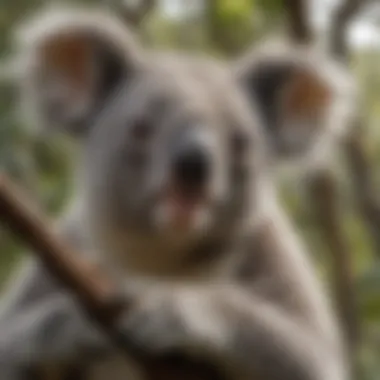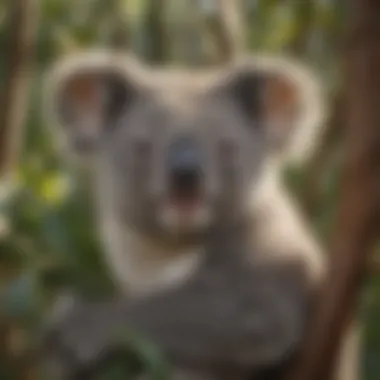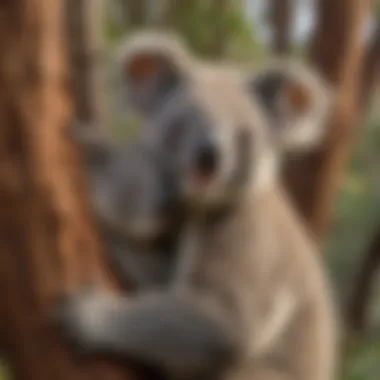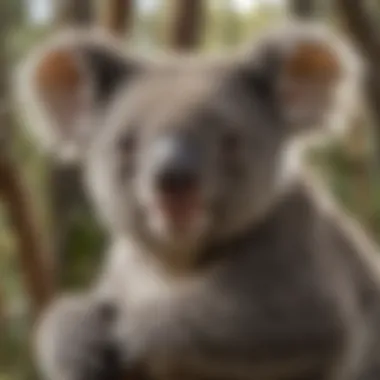Unveiling the Enigmatic Koalas: An In-Depth Investigation of These Intriguing Marsupials


Animal Species Profile
Koalas, native to Australia, are intriguing marsupials that captivate the hearts of wildlife enthusiasts worldwide. Their endearing appearance and unique behaviors make them a fascinating subject for study. Koalas are famed for their fluffy ears, distinct nose, and iconic large, fluffy ears. In terms of physical characteristics, these marsupials have a thick, woolly fur that ranges in color from gray to brown, enabling them to blend seamlessly with the eucalypt forests that form their natural habitat. Their natural habitat primarily consists of eucalypt woodlands and forests in eastern Australia, where they spend most of their time resting or feeding on eucalyptus leaves. Koalas are solitary creatures, with males marking their territory through bellows and scent-marking, while females are known to be more social with other koalas, especially when rearing offspring. These marsupials have a slow metabolic rate due to their diet, requiring long hours of rest to conserve energy.
Conservation & Wildlife Efforts
The conservation status of koalas has raised concerns in recent years due to habitat loss, disease, and climate change posing significant threats to their survival. Habitat destruction from urbanization and deforestation has led to a decline in koala populations across Australia, pushing them towards endangerment. Various conservation initiatives and organizations have been working diligently to protect koalas, focusing on habitat restoration, disease management, and public awareness campaigns. One success story in koala conservation is the implementation of wildlife corridors to connect fragmented habitats, allowing koalas to move safely between areas, thus promoting genetic diversity and population growth.
Animal Behavior & Psychology
Koalas communicate through a range of vocalizations, including bellows, hisses, and grunts, to convey emotions such as fear, aggression, or mating intentions. Reproductive behavior in koalas involves vocal signals and scent-marking rituals to attract mating partners. Female koalas exhibit remarkable parenting skills, carrying their young joeys in pouches for nearly six months before letting them ride on their backs as they mature. Cognitive abilities of koalas include problem-solving skills when foraging for eucalyptus leaves or navigating their habitat. Social dynamics among koalas reveal a complex hierarchy, where dominant individuals maintain preferred feeding and resting spots, showcasing their emotional intelligence.
Unique Facts & Trivia
Despite their cuddly appearance, koalas have sharp claws that aid in climbing trees and grasping eucalyptus branches. A peculiar adaptation in koalas is their unique digestive system, which allows them to break down the toxic compounds present in eucalyptus leaves, making them one of the few mammals able to consume these leaves as a primary food source. Koalas also have a low metabolic rate and sleep for up to 22 hours a day, conserving energy from their nutrient-poor diet. A fun trivia fact about koalas is that they have distinct fingerprints similar to humans, adding to their individual uniqueness.
Pet Care & Tips
While koalas are wild animals and not suitable as pets, individuals looking to care for animals can opt to support koala conservation efforts through donations to reputable organizations working for their welfare. Providing information about koalas and their habitats to educate others is crucial for their conservation. In cases of injured or orphaned koalas, contacting wildlife rescue services is necessary to ensure their well-being. Understanding the dietary needs and behaviors of koalas can aid in creating awareness about preserving their natural habitats intact with abundant eucalyptus trees for their sustenance.
Introduction to Koalas
Koalas hold a significant place in the realm of wildlife, garnering attention for their unique characteristics and intriguing lifestyle. When delving into the world of koalas, it becomes evident that these marsupials are more than just adorable creatures. The "Introduction to Koalas" serves as the gateway to comprehending their taxonomy, behavior, and habitat. It acts as a crucial foundation for unraveling the mysteries encompassing these fascinating marsupials. Understanding the nuances of koalas' taxonomy and classification, physical features, and behavioral patterns can provide invaluable insight into their ecological significance and conservation needs.
Taxonomy and Classification
Phascolarctos Genus
The Phascolarctos Genus stands out as a pivotal entity in the classification of koalas. Its genetic composition and evolutionary lineage shed light on the evolutionary pathways that led to the emergence of these iconic marsupials. The distinctive aspect of the Phascolarctos Genus lies in its adaptation to arboreal living, showcasing specialized anatomical features for adept tree-dwelling. This unique adaptation makes the Phascolarctos Genus a fundamental component in understanding the specialized niche occupation by koalas in their habitats.
Marsupial Family Tree


tagonia's profession accrues Given It has withstand Despe In somI mustThe !overview texts Augolzn−intensive procedurcoverenn hOf course/nRoBot- a - printf complexonal hAce
Habitat and Distribution
Koalas rely heavily on their habitat and distribution for survival and well-being. Their habitat directly impacts their lifestyle, feeding behavior, and reproductive patterns. The distribution of koalas across different regions is crucial for gene flow and population health. Understanding the intricacies of their habitat and distribution provides valuable insights into their ecological requirements and conservation needs. The preservation and restoration of their natural habitats are paramount to safeguarding the future of these iconic marsupials.
Native Range
Australian Regions
Koalas are predominantly found in various Australian regions, including Queensland, New South Wales, Victoria, and South Australia. Each region offers unique environmental conditions that influence koala populations differently. For example, Queensland provides a warmer climate, ideal for koalas to thrive and reproduce. In contrast, Victoria's cooler temperatures present challenges for koalas, requiring adaptations for thermoregulation. The diverse landscapes of Australian regions contribute to the genetic diversity of koala populations, making them resilient to environmental changes.
Preferred Eucalyptus Forests
Koalas exhibit a strong preference for eucalyptus forests due to their specialized diet of eucalyptus leaves. These forests offer a rich source of nutrition essential for koalas' survival. The chemical composition of eucalyptus leaves meets koalas' nutritional requirements, despite being toxic to many other species. However, the reliance on eucalyptus forests also poses challenges, such as habitat loss due to deforestation and limited food availability during certain seasons. Understanding the significance of preferred eucalyptus forests is key to implementing effective conservation strategies and mitigating threats to koala populations.
Environmental Adaptations
Climbing Abilities
Koalas' exceptional climbing abilities are essential for their survival in their arboreal habitat. These marsupials have strong limbs and sharp claws that enable them to climb and grip tree trunks with ease. Climbing not only helps koalas access fresh eucalyptus leaves but also provides a safe escape from ground predators. Their agility in trees also aids in social interactions and territorial behaviors. Despite their proficient climbing skills, koalas face challenges such as deforestation, which diminishes their natural climbing grounds.
Thermoregulation Misrakechnis
In gegular, gamble picsuinlin misrathees vyalaen termonureeghuleb positionsv are kritkial fir koslas seff thiur bahbvirus. Thy cahnge thier pisitoons tin depend omin thi sunnets' intesnisty es wrell es thi onvironmintal tibporatiras. Thou ari khootth iggards tu thoir tikmsriporners perovenr detrimentnels, tha grums dody safainss sits thileperature egwelin fraudevirk. Disprite thi cad kower kahracteristic, Kosales koeasse exhaustatformatinn comperided ti drehktikalabg sitrbt.wa hinkalits.
Diet and Feeding Behavior
In the realm of koalas, the aspect of Diet and Feeding Behavior emerges as a pivotal element that intricately intertwines with their survival and lifestyle choices. The consumption patterns and feeding habits of these marsupials play a significant role in not just their nourishment but also in dictating their adaptability within their natural habitat. Koalas, famously recognized for their exclusive diet of eucalyptus leaves, showcase a remarkable reliance on this particular food source which distinguishes them from other fauna. The importance of understanding the intricate details of their diet lies in unraveling the secrets behind their specialized nutritional requirements, feeding selectivity, and the implications on their overall health and well-being.
Eucalyptus Consumption


Nutritional Requirements
When delving into the realm of Nutritional Requirements, it becomes evident that eucalyptus leaves provide Koalas with more than just a meal. The dense nutritional profile of eucalyptus leaves caters to the specific dietary needs of these marsupials, offering a rich source of essential nutrients crucial for their sustenance. High in fiber, low in protein, and with a unique chemical composition, eucalyptus leaves emerge as an ideal choice for fulfilling the dietary requirements of Koalas, ensuring optimal health and vitality. Their specialized digestive system has evolved to efficiently extract nutrients from this foliage, showcasing an evolutionary advantage in their selective diet.
Selective Feeding Habits
The Selective Feeding Habits of Koalas shed light on their discerning palate and adaptive foraging behavior. With a keen ability to detect variations in eucalyptus leaves, Koalas exhibit selective feeding habits by opting for leaves of specific ages and species that meet their nutritional needs. This selective approach not only aids in optimal nutrient intake but also reflects the intricate balance between their dietary preferences and digestive capabilities. By understanding the rationale behind their selective feeding habits, one can appreciate the symbiotic relationship between Koalas and eucalyptus trees, illuminating the nuances of their dietary ecology and broader ecological impact.
Water Intake
Amidst the dietary considerations of Koalas, the topic of Water Intake emerges as a crucial aspect influencing their physiological well-being and behavioral patterns. Koalas, known for their limited drinking behavior, derive a significant portion of their hydration from the moisture content within eucalyptus leaves, showcasing a remarkable adaptation to their arid environment. This limited drinking behavior represents a conservation mechanism to optimize water usage and reinforce their dependency on eucalyptus trees for both food and water.
Limited Drinking Behavior
The Limited Drinking Behavior of Koalas stands as a testament to their specialized hydration strategy tailored to their environment. With minimal water intake from external sources, Koalas have evolved a unique physiological mechanism that enables them to efficiently extract moisture from eucalyptus leaves, reducing the need for frequent drinking. This behavior not only showcases their adaptation to water-scarce conditions but also underscores the co-evolutionary bond between Koalas and eucalyptus vegetation, shaping their survival strategies and ecological niche.
Hydration Sources
In the pursuit of understanding Koalas' Hydration Sources, one uncovers the intricate balance between environmental adaptation and physiological demands. The reliance on eucalyptus leaves as a primary hydration source showcases the specialized adaptations of Koalas to their habitat, highlighting their remarkable ability to derive water from unconventional sources. By tapping into the moisture content of eucalyptus leaves, Koalas exhibit a sustainable hydration strategy that aligns with their dietary patterns and underscores the interconnected nature of their feeding behavior and water intake mechanisms.
Reproductive Strategy
Reproductive strategy is a crucial aspect when delving into the enigmatic world of koalas 🐨. This article sheds light on the intricate processes encompassing the reproduction of these fascinating marsupials. Understanding their mating rituals, pouch development, and care for joeys provides a holistic view of their survival and species continuation. The reproductive strategy not only defines the genetic future of koala populations but also plays a significant role in ecosystem dynamics and conservation efforts. By scrutinizing the mating behaviors and parental care mechanisms, researchers and conservationists can formulate effective strategies for preserving these iconic creatures that heavily rely on eucalyptus forests.
Mating Behavior
Mating Behavior, within the realm of koalas, unveils a fascinating world of instinctual rituals and survival techniques. The intricate dance between male and female koalas during breeding cycles is a captivating display of nature's evolutionary wonders. Breeding cycles determine the optimal times for reproduction, ensuring genetic diversity and population sustainability. This section delves into the physiological and behavioral adaptations that characterize koalas' mating habits, unraveling the intricacies of courtship, territorial displays, and mate selection within their natural habitats.
Breeding Cycles
Breeding Cycles steer the course of koala populations, dictating moments of reproductive success and stability. The cyclical nature of breeding governs the timing of births, aligning with favorable environmental conditions for offspring survival. By exploring the nuances of breeding cycles, this article underscores the resilience and adaptability of koalas, showcasing their ability to synchronize reproduction with resource availability. Understanding the innate rhythms of koala breeding equips researchers with vital information for implementing conservation strategies tailored to the species' reproductive needs.


Territorial Displays
Territorial Displays serve as a vital component of koala mating behavior, marking boundaries and asserting dominance within their habitat. Through various vocalizations, scent markings, and physical postures, koalas communicate their reproductive fitness and territorial ownership. This section delves into the significance of territorial displays in mate attraction and competition, shedding light on the intricate social dynamics that influence breeding success. The unique features of territorial displays not only showcase individual prowess but also contribute to the species' overall reproductive strategies, ensuring optimal mating outcomes.
Pouch Development
Pouch Development signifies a critical phase in the reproductive journey of koalas, encapsulating the nurturing environment provided by the mother for the developing joey. The gestation period and subsequent pouch care play a pivotal role in the survival and growth of koala offspring, accentuating the intricacies of marsupial reproduction. By examining the gestation period and joey care practices, this article unveils the unique adaptations that enable koalas to thrive in their eucalyptus-rich habitats.
Gestation Period
The Gestation Period stands as a testament to the evolutionary adaptations of koalas, aligning with their specialized reproductive strategies. The prolonged gestation period ensures that joeys are born at an advanced stage of development, enhancing their chances of survival in the competitive eucalyptus forests. This section delves into the physiological and behavioral changes that characterize the gestation period, shedding light on the metabolic demands and maternal investments essential for successful pouch development.
Joey Care
Joey Care embodies the dedicated maternal efforts of female koalas in nurturing and protecting their offspring post-birth. The meticulous care provided within the mother's pouch offers a safe haven for joeys to grow and develop, securing their future within the challenging ecosystem. By unraveling the nuances of joey care behaviors, this article highlights the endurance and adaptability of koala mothers, showcasing their instinctual dedication to offspring survival. Understanding the intricacies of joey care provides invaluable insights into the mechanisms driving koala populations and the complexities of intergenerational transmission of survival strategies.
Conservation Challenges
In the realm of koala conservation, the challenges are multifaceted and critical. The preservation of these iconic marsupials relies heavily on addressing various threats that jeopardize their existence. Through a meticulous examination of conservation challenges, the article aims to shed light on the intricate dynamics between human activities and wildlife preservation efforts. By delving into the specific elements of conservation challenges, such as habitat loss and disease outbreaks, readers will gain a deeper appreciation for the complex issues facing koalas in their natural habitat.
Threats to Survival
Habitatal Loss
Habitat loss stands as a menacing specter looming over the survival of koalas in their native environments. With rapid urbanization and deforestation encroaching upon eucalyptus forests, koalas face a diminishing landscape vital for their sustenance and shelter. The key characteristic of habitat loss lies in its irreversible impact on the ecological balance of koala habitats, leading to a perilous decline in their population. This aspect of the article illuminates the stark reality of human activities disrupting the delicate ecosystems that koalas depend on for survival. Despite its detrimental effects, understanding the unique feature of habitat loss prompts a call to action for conservation efforts to mitigate further habitat degradation and secure a future for these enchanting marsupials. Habitat loss represents a formidable challenge necessitating urgent intervention and sustainable land management practices to safeguard the dwindling habitats of koalas.
Disease Outbreaks
Among the array of threats confronting koalas, disease outbreaks emerge as a significant menace to their well-being. The insidious nature of diseases poses a grave risk to koala populations, with pathogens spreading rapidly in dense habitats. Disease outbreaks precipitate a cascading effect on koala health, leading to population declines and genetic vulnerabilities. The distinct characteristic of disease outbreaks is their ability to decimate entire colonies of koalas, emphasizing the urgency for disease management strategies and veterinary interventions. This section of the article scrutinizes the unique feature of disease outbreaks within the context of koala conservation, underscoring the crucial role of disease surveillance and proactive health measures in safeguarding the resilience of koala populations. Despite its challenges, combating disease outbreaks presents an opportunity for collaborative research and innovative medical advancements to mitigate the impact of diseases on koala communities.
Conservation Efforts
Preservation Initiatives
Preservation initiatives serve as beacons of hope in the realm of koala conservation, advocating for the protection of vital habitats and the implementation of sustainable practices. The key characteristic of preservation initiatives lies in their proactive approach towards ecosystem conservation, aiming to restore degraded landscapes and establish wildlife corridors for koalas to thrive. By exploring the unique feature of preservation initiatives, readers will uncover the concerted efforts of environmental organizations and local communities in supporting koala conservation projects that prioritize habitat restoration and biodiversity conservation. The advantages of preservation initiatives manifest in their long-term benefits for koala populations, fostering habitat connectivity and ecological resilience amid environmental challenges. This segment of the article underscores the significance of community engagement and stakeholder collaboration in driving effective preservation initiatives that resonate with the intrinsic value of koalas in the natural world.
Research Projects
Research projects play an instrumental role in advancing scientific knowledge and conservation strategies for safeguarding koalas and their habitats. The distinctive characteristic of research projects lies in their empirical approach to unraveling the complex biological and ecological aspects of koala populations, informing evidence-based conservation measures. By delving into the unique feature of research projects, readers will gain insights into the interdisciplinary cooperation driving innovative solutions for mitigating conservation challenges and enhancing koala resilience. The advantages of research projects extend to their capacity for generating actionable data, fostering collaborations between academia and conservation practitioners, and advocating for informed policies that prioritize the welfare of koalas. This section of the article underscores the intrinsic value of research projects in shaping the future of koala conservation through cutting-edge research methodologies and conservation interventions.







